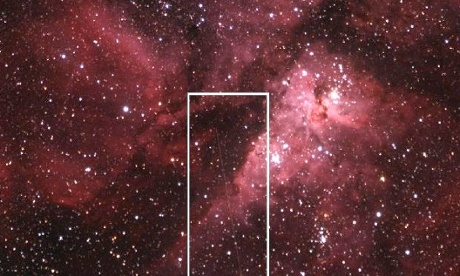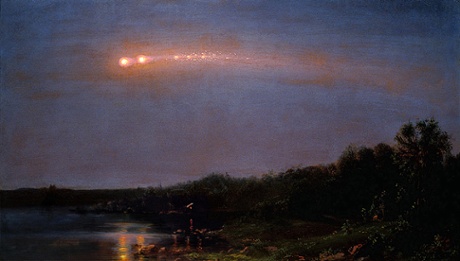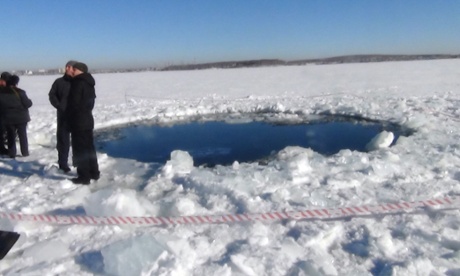February 2013 16.22 EST
February 2013 16.22 EST
Meteorite slams into Central Russia injuring 1100 - live updates
LIVE• Ministry says 1,100 sought care, 48 hospitalized - AP
• Dramatic pictures show meteor streaking through sky
• Multiple impact sites confirmed
• Read our latest news story on the meteor
• Read the latest blog summary
• Dramatic pictures show meteor streaking through sky
• Multiple impact sites confirmed
• Read our latest news story on the meteor
• Read the latest blog summary
The Guardian's Warren Murray picks up on the questions we raised earlier about the minutes-long time lapse between when the meteor was first sighted and when the first of a series of booms was heard.
It simply took the sound waves that long to travel the distance to the observer, he writes. And the series of booms is attributable to multiple shock waves created by the meteor(s):
In our coverage we've remarked on the fact that the sonic boom in some videos happens a couple of minutes after the meteor passes.This isn't surprising, it just means the camera was at sufficient distance that the sound took a while to reach it. Sound travels at 330km/h, so a three-second delay would mean you're a kilometre away roughly. A 30-second delay, roughly 10km etc. And the thing would have been visible to people and cameras from a long, long way away, even though the size and brightness would have made it seem quite close for many people who were in fact a long way off.Also, a sonic boom doesn't happen at any particular instant or point in time, i.e. when the object first entered the atmosphere or first broke the sound barrier. The shockwave and the boom follows the object along its entire path as long as it's supersonic, so anyone it goes past will hear a boom. That's one reason why international agreement was never reached for the Concorde to fly supersonic across whole continents or populated areas - it would have created huge noise pollution all the way along its supersonic path.Then there's the multiple sonic booms issue. Put simply, a body going supersonic creates multiple shock waves and therefore can make multiple booms: one in front, one behind, plus others potentially. This partly depends on its shape, changes in trajectory etc. The space shuttle was always known for two booms. Also, consider how very loud those booms in Russia would have been, and the fact that echoes off the sides of mountains etc would have in turn travelled a very long way and been heard some time afterwards.
Updated
Phil Plait, author of the Bad Astronomy blog at Slate, participated in a Google+ hangout today in which he explained why today's asteroid near-miss wasn't really as close as some folks are saying.
Fast-forward to 29:45 to watch Phil use a foam Earth, a lamp and a hunk of real meteorite to explain what happened.
Updated
NASA captures a picture of Asteroid 2012 DA14 and the Eta Carinae Nebula. The white box highlights the asteroid's path.
The full-size image is here and it's worth a click.

The image was taken using a 3" refractor equipped with a color CCD camera. The telescope is located at the Siding Spring Observatory in Australia and is maintained and owned by iTelescope.net.
For Elif Batuman, the meteor over Russia recalled a passage from War and Peace, in which Tolstoy describes the great comet of 1812, aka thegreat comet of 2011:
Only looking up at the sky did Pierre cease to feel how sordid and humiliating were all mundane things compared with the heights to which his soul had just been raised…. Above the Prechistenka Boulevard, surrounded … on all sides by stars but distinguished from them all by its nearness to the earth, its white light, and its long uplifted tail, shone the enormous and brilliant comet of 1812—the comet which was said to portend all kinds of woes and the end of the world. In Pierre, however, that comet with its long luminous tail aroused no feeling of fear. On the contrary he gazed joyfully, his eyes moist with tears, at this bright comet which, having traveled in its orbit with inconceivable velocity through immeasurable space, seemed suddenly—like an arrow piercing the earth—to remain fixed in a chosen spot, vigorously holding its tail erect, shining and displaying its white light amid countless other scintillating stars. It seemed to Pierre that this comet fully responded to what was passing in his own softened and uplifted soul, now blossoming into a new life.
Updated
2012 DA14 has passed the point of nearest proximity and is moving away from Earth again, the AP reports from Cape Canaveral, Florida:
The world is safe at least from one asteroid.
A 150-foot (46-meter) cosmic rock hurtled safely past Earth on Friday.
It was the closest known flyby for a rock of its size, passing within 17,000 miles (27,357 kilometers). That's closer than some satellites.
Updated
The asteroid #2012DA14 is approaching the point of its nearest proximity to Earth, the European Space Agency says. NASA streaming video is here.
Updated
The meteor is only the latest wild event to be captured by Russian dash cams. Herewith a roundup of other highlights:
Car dashboard mounted cameras, known as 'dash-cams', record a multitude of near misses on Russian roads. Russians use the cameras to gather evidence in support of their insurance claims, where bad roads, extreme weather, drink driving and aggressive drivers produce a high accident rate. Russia had 35,972 traffic-related deaths in 2009, according to the World Health Organisation (n.b.: no humans, or cows, were harmed in the making of this video).
Updated
Walt Whitman, Frederic Church and the meteor procession of 1860
Until a eureka moment 13 years ago, astronomers puzzled over the precise nature of a celestial event described by Walt Whitman in hispoem "Year of Meteors (1859-60)."
The poem is a kind of recap of the year in question. Whitman allows himself to dwell on the visit of Prince Albert Edward to New York ("And you would I sing, fair stripling! welcome to you from me, sweet boy of England! ...I know not why, but I loved you...")
Then the poem mentions a "strange huge meteor procession, dazzling and clear, shooting over our heads":
Nor the comet that came unannounced out of the north, flaring in heaven;Nor the strange huge meteor procession, dazzling and clear, shooting over our heads,(A moment, a moment long, it sail’d its balls of unearthly light over our heads,Then departed, dropt in the night, and was gone;)
In time the celestial event Whitman referred to was forgotten, and astronomers, lacking Russian daschcam footage, began wondering just what he had seen. An 1859 "daylight fireball" and the 1833 Leonid meteor shower were contenders, the LA Times reported.
Then, in 2000, astronomer Don Olson was looking at an art book and saw this painting by Frederic Edwin Church. It's called The Meteor of 1860:

Olson realized that here was the event to which Whitman was referring. He drew together a team of astronomers and a literary scholar from Texas State University, and in 2010 they published their results in Sky and Telescope magazine.
The Times' Amina Khan explains:
The astronomer recognized this as an extremely rare event that is in fact called a "meteor procession," in which a meteor breaks up and the pieces travel together as if in formation before exiting the Earth's atmosphere once more.A procession is rare, Olson said, because so many factors need to fall into place. The meteor, known as a grazer, must travel almost tangent to the Earth's surface, giving it a long, near-horizontal path across the skies. It usually has to travel between about 35 and 40 miles above the ground — any higher and it would not light up, any lower and it would likely fall to Earth. And it has to break up very soon after entering the Earth's atmosphere, or the procession-like effect will be lost.
Updated
The Russian interior ministry now says about 1,100 sought care after the meteor blast, the AP reports:
The shock wave blew in an estimated 100,000 square meters (more than 1 million square feet) of glass, according to city officials, who said 3,000 buildings in the city were damaged. At one zinc factory, part of the roof collapsed.The Interior Ministry said about 1,100 people sought medical care after the shock wave and 48 of them were hospitalized. Most of the injuries were caused by flying glass, officials said..."I went to see what that flash in the sky was about," recalled resident Marat Lobkovsky. "And then the window glass shattered, bouncing back on me. My beard was cut open, but not deep. They patched me up. It's OK now."
The first Soviet atomic weapons were manufactured near Chelyabinsk, and the region is badly contaminated from nuclear waste. The Washington Post's Max Fisher points to a 2007 Time report:
Chelyabinsk isn’t far from the massive Mayak nuclear complex, which processed materials for the first Soviet atomic weapons. During the 1940s and ’50s, Mayak pumped nuclear waste directly into the rivers that ran through villages in the area, exposing hundreds of thousands to dangerous levels of radiation. Though dumping has been since halted, many of the region’s waterways remain at least faintly radioactive, and residents still suffer from elevated cancer rates.
But in a strange juxtaposition, the region is also a frolicking ground for new money:
That sentiment seems to be shared by many of the region's nouveaux riches, who have flocked to build summer mansions along the region's lakes. Indeed, with basic infrastructure failing to even come close to keeping pace with development, the garbage produced by the holiday-makers may pose more of a threat to the environment than does the Mayak nuclear waste.
Updated
The meteor that appeared over Russia this morning described a vectorperpendicular to that of the asteroid flying by Earth later today. The Telegraph has an elegant graphic illustrating the paths of the meteor and the asteroid.
For readers in Australia, Asia, Africa and Europe, the BBC has produced a video explaining how you can see the asteroid in the evening sky.
Readers in the Americas will have to wait for video, of which no shortage is expected.
Updated
The meteor explosion released as much energy as a nuclear blast, Nature magazine reports – a blast much larger than North Korea's recent test:
Infrasound data collected by a network designed to watch for nuclear weapons testing suggests that today's blast released hundreds of kilotonnes of energy. That would make it far more powerful than the nuclear weapon tested by North Korea just days ago and the largest rock crashing on the planet since a meteor broke up over Siberia's Tunguska river in 1908."It was a very, very powerful event," says Margaret Campbell-Brown, an astronomer at the University of Western Ontario in London, Canada, who has studied data from two infrasound stations near the impact site. Her calculations show that the meteoroid was approximately 15 metres across when it entered the atmosphere, and put its mass at around 40 tonnes. "That would make it the biggest object recorded to hit the Earth since Tunguska," she says.
(h/t: @DrStuClark)
It's still unclear what landed where. The thing left some pretty big holes.

In terms of human casualties, Friday's meteorite strike is the worst ever reported, Stuart Clark writes on his Across the Universe blog:
Before this there were only stories of a dog being killed in Egypt by a meteorite in 1911 and a boy being hit, but not seriously injured, by one in Uganda in 1992....Until Friday morning, astronomers had thought the asteroid most likely to hit Earth was one called 2007 VK184. It is about 130 metres across and has a slim 1 in 2,000 chance of hitting Earth some time between 2048 and 2057. A danger that is thought will disappear with better tracking of its orbit.
Clark says better asteroid vigilance is needed:
Friday's unexpected strike highlights the need for better searches for dangerous asteroids, and a global strategy to deal with any that are seen.
Full post well worth a read here.
Updated
Minutes passed between sighting and loud boom
Another video is below of the meteor's giant double contrail and an explosion, at around 25 seconds in, which then is followed by smaller unidentified pops. (Watch to the end to see the rather unbothered reaction of the locals, dressed for winter.)
How long after the meteor entered the atmosphere did the sonic boom happen? The video below makes it clear that there was some gap between when the meteor crossed the sky and when the explosion is heard.
UPDATE: Read Warren Murray's explanation here.
And in this video, the meteor crosses the sky a full 2 minutes and 20 seconds before the explosion is heard (the video also captures what seems to be the unidentified popping afterwards).
Here's how Tim O'Brien, associate director of the University of Manchester's Jodrell Bank Observatory, described the boom and the time gap (we quoted O'Brien in a post earlier today):
This reasonably large chunk of rock was moving faster than the speed of sound, maybe 20,000 miles per hour. It made a sonic boom in the atmosphere, and that hit buildings and shattered windows. That is what seems to have caused the injuries.It's a completely abnormal experience. This thing appeared in the distance, raced over the horizon and was followed up 30 seconds or a minute later by a huge boom as the shock wave hit the ground. I can imagine that would be very frightening.
In fact the boom happened for some witnesses more than two minutes after the meteor came visible, and smaller pops followed the boom.
No comments:
Post a Comment